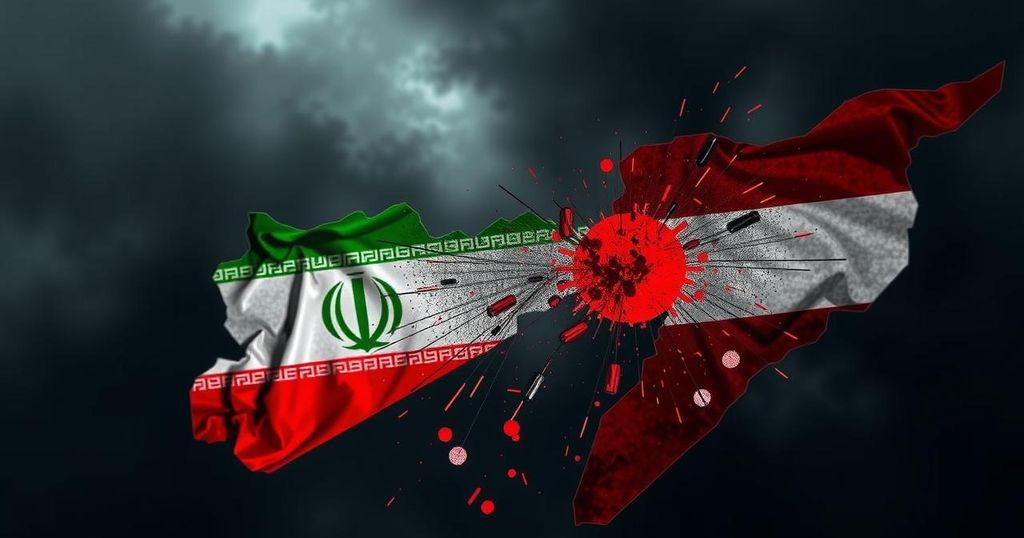Iran is facing considerable difficulties in supporting the Assad regime in Syria due to weakened proxy forces, including recent losses by Hezbollah and increased threats from groups like Hayat Tahrir al-Sham (HTS). The Iranian leadership has acknowledged these challenges, blaming US and Israeli interference for setbacks in the region. Ongoing military and diplomatic efforts aimed at countering opposition forces highlight Iran’s struggle to maintain its influence within the conflict.
Iran is currently experiencing significant challenges in its attempts to support the Syrian regime, particularly in light of recent setbacks impacting its network of allied forces, known as the “Axis of Resistance.” This coalition includes Hezbollah, Hamas, the Houthis, Iraqi militias, and the Syrian government. Following an upsurge in violence initiated by Hamas against Israel on October 7, Iran mobilized its allies to retaliate, with Hezbollah initiating strikes on Israel a day later. However, these efforts have not produced the desired results, as Iranian state media has acknowledged setbacks to the Syrian regime, attributing them to American and Israeli interference.
In a recent statement, Iranian Armed Forces Chief of Staff Major General Mohammad Bagheri indicated that rising terrorist activities in Syria are part of an orchestrated plan by the US and Israel to undermine the Syrian government and its allies. This revelation indicates a significant recognition of failure on Iran’s part. The Iranian leadership is now striving to reinforce support for Syrian President Bashar al-Assad’s regime amidst escalating challenges from adversarial groups, particularly Hayat Tahrir al-Sham (HTS), which recently captured key territories.
Additionally, ongoing clashes between the US-backed Syrian Democratic Forces (SDF) and regime forces in the Euphrates River valley threaten the Assad regime’s control over this crucial region. The US has provided air support to the SDF, compounding the pressures on Iranian and Syrian forces.
Hezbollah’s diminished military capacity following extensive losses in conflicts with Israel over the past two months also complicates Iran’s position. Reports suggest Hezbollah may have lost over 3,000 fighters, severely limiting its operational capabilities in Syria. Consequently, Iran’s reliance on its allies is increasingly precarious, prompting high-level diplomatic efforts with neighboring countries to discuss the deteriorating situation.
The Iranian military has initiated dialogues with regional partners, including Russia, to address the unfolding crisis. Major General Bagheri articulated concerns about terrorist resurgence in northwestern Syria amidst heightened tensions and suggested that current escalations in Aleppo and Hama may be strategically aligned with a fragile ceasefire in the region orchestrated by foreign powers. Furthermore, the involvement of senior Iranian Revolutionary Guard Corps (IRGC) officials denotes a heightened emphasis on maintaining influence and territorial integrity in Syria, although doubts remain about Iran’s capacity to effectively deploy forces.
Given the absence of significant reserves within the Syrian military and the reluctance of Iran and Russia to commit ground troops, the IRGC faces substantial pressure to reassess its strategies and possibly negotiate with Turkey to mitigate the threat posed by HTS. The situation remains tense, and Iran’s ability to sustain its support for the Assad regime is under increasing scrutiny as complications mount.
The conflict in Syria has pitted various regional and international actors against each other in a complex geopolitical landscape. Iran’s involvement is primarily aimed at supporting its ally, the Assad regime, and maintaining its influence in the region through the “Axis of Resistance,” which encompasses militant groups that share a common enemy in Israel and opposing forces in the region. As the Syrian civil war drags on, Iranian support for Assad has been critical, involving both military and political aspects. However, setbacks among their proxies and increasing military pressures from both local opposition groups and US-backed forces have raised concerns about Iran’s effectiveness in sustaining the regime’s power and its broader regional ambitions.
In conclusion, Iran’s position in Syria is increasingly precarious as it confronts significant setbacks in its efforts to support the Assad regime. The weakening of its proxy forces and ongoing clashes with adversarial groups underscore the challenges Iran faces in maintaining influence in the region. High-level discussions with regional allies illustrate Iran’s recognition of the gravity of the situation. However, the lack of military resources and potential strategies to counteract HTS’s advances remain critical factors that could determine Syria’s future trajectory and Iran’s role within it.
Original Source: www.jpost.com






